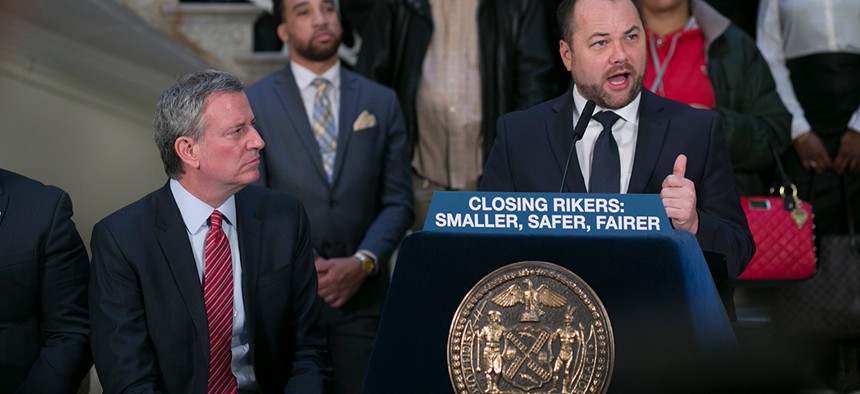New York City
Rikers Island should get green infrastructure
When Rikers Island closes, use the land to fight climate change, pollution and environmental injustice.

New York City Council Speaker Corey Johnson and Mayor Bill de Blasio announce the closing of Rikers Island. William Alatriste for the New York City Council
When the jail on Rikers Island finally closes, New York City needs to make sure the land there serves New Yorkers, instead of harming them.
We have a once-in-a-lifetime opportunity for Rikers Island to clear multiple roadblocks so New York City can fight climate change in a meaningful way. The right investment will allow us to build a solar farm, a wastewater treatment plant, and perhaps a sustainable green space there – even in the next few years. Doing so eliminates the need for the power plants and other aging facilities that have only widened the opportunity gap in places such as the Queensbridge Houses, Sunset Park and the South Bronx. New York City has been powered off the backs of these communities for too long, as many in power ignored the physical and social effects on these people.
Of course, Rikers as it currently stands should be closed down. About 7,000 people are incarcerated daily on Rikers and in other New York City jails while awaiting trial, representing all that’s wrong with our broken cash bail system. Parts of the detention center were for generations governed by a “deep-seated culture of violence,” as a damning U.S. Justice Department probe found merely five years ago. This place has become a model for the failures of mass incarceration.
Locking up a disproportionate share of men of color – many on low-level, non-violent charges – has decimated communities. These were the same groups that, less than 20 years ago, were denied a voice when harmful gas-fired power plants were foisted upon their neighborhoods. These plants, residents were promised, would operate for just three years. Yet here they still stand, spewing harmful toxins into the lungs of young children, who are more at risk of getting asthma, and thus more likely to miss important school days.
That is why we partnered to expand former Chief Justice Jonathan Lippman’s suggestion two years ago that these 400 acres be used for environmental infrastructure once this house of horrors closes. LaGuardia Airport’s proximity makes housing on Rikers Island nearly impossible, and building another runway there is unfeasible for many reasons. Along with a proper memorial to past suffering, we have an attainable plan for Rikers to become the centerpiece in the fight against violent weather, rising sea levels and air pollution.
Using just one-quarter of Rikers Island for renewable energy will have ripple effects through these communities. Dedicating 100 acres for solar panels and large-scale batteries can close most – if not all – of the secondary power plants built throughout the five boroughs in the last two decades. It would help create a truly green electrical grid and propel New York City steadily toward its goal of 80 percent greenhouse gas emissions reduction by 2050.
An estimated 20,000 people statewide could work in solar energy by 2021 with the right policies, a significant increase from the 9,729 we employed across the Empire State last year. Dedicating 100 acres to solar at Rikers Island alone only ensures New York City will have a bulk of these good jobs. Solar work requirements also vary from a high school to a bachelor’s degree, so we must explore the feasibility of people previously incarcerated on Rikers filling some of these jobs.
Eliminating power plants means smokestacks can come down, and those white plumes filled with the worst toxins disappear with them. That will be a major benefit to the surrounding communities, many of which have higher levels of the harmful PM2.5 toxin than the rest of the city. Pollutants sent out by the Ravenswood Generating Station in western Queens, one of the dirtiest in the state, have caused us to experience higher asthma rates than the boroughwide average. And too often those numbers represent NYCHA residents in the Queensbridge, Ravenswood and Astoria houses. Historically, these communities were ignored when it came to investing in western Queens, but this is an opportunity to break that cycle.
New York City’s ambitious environmental goals can go even higher by also targeting our wastewater treatment plants. Facilities in Astoria, College Point and the South Bronx were all built about 80 years ago when the city had about a million fewer people than today. Because these centers can’t handle 21st century realities, they are forced to send excess waste into our waterways anytime it rains more than half an inch. Sewage thus pours into coves and bays, just a few feet from Little League fields.
After spending a generation reclaiming our dilapidated waterfront, do we want to continue pouring human waste into the areas in which we want people to fish or kayak? Frankly, the whole thing stinks. New York City could close these facilities and replace them with a state-of-the-art wastewater treatment plant – one that’s resilient to the realities of climate change. Such a bold move opens up the waterfront for public uses or affordable housing.
History will either remember this as a time of bold action to right the wrongs of our past, or an era of missed opportunity because we slow-walked important policies when we needed urgency. What has happened at Rikers Island is a stain on the history of our great city. This dark chapter New York City must end. There is no reason we cannot start a new one, however, that rights some of the wrongs committed both here as well as in the communities it has torn apart.

